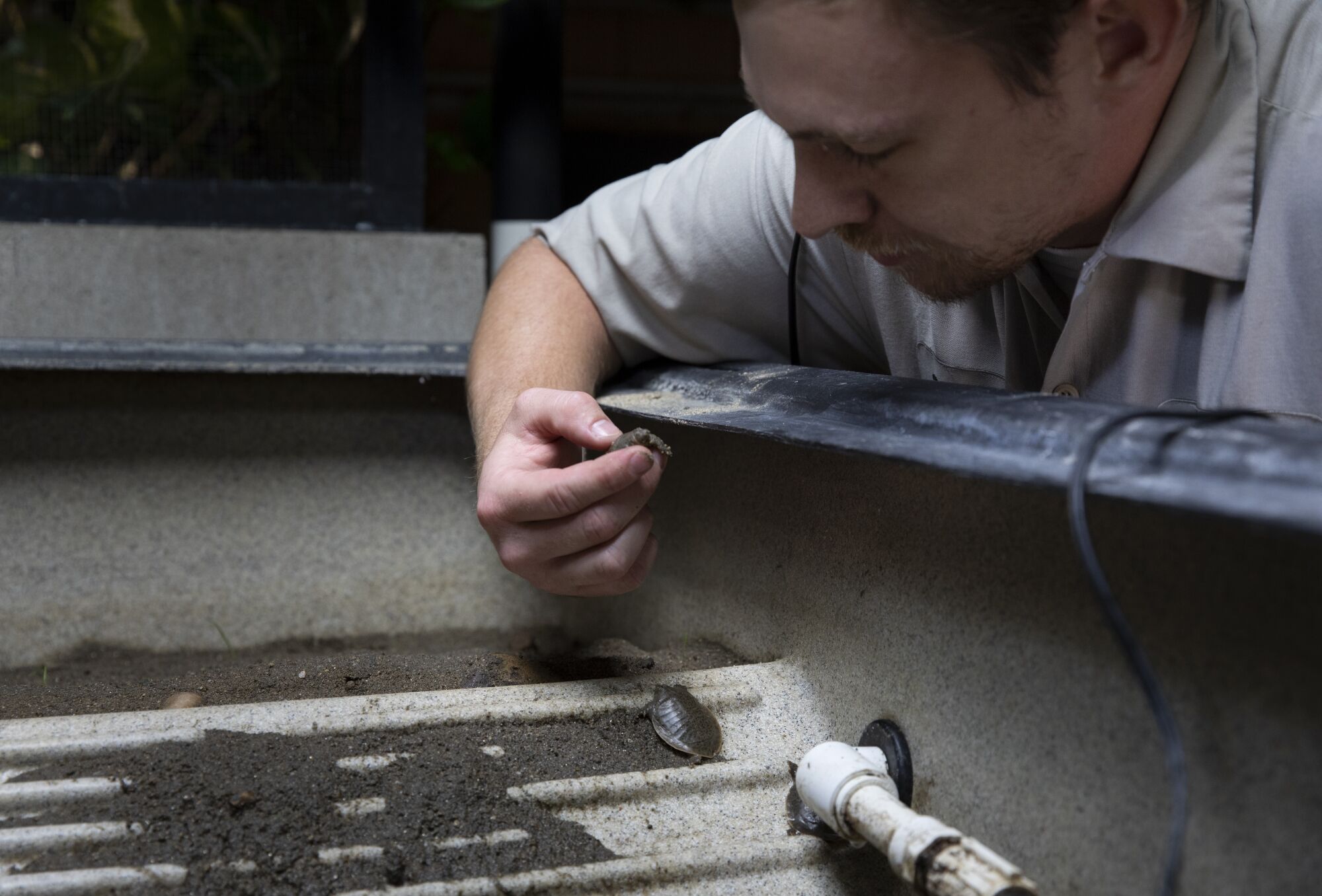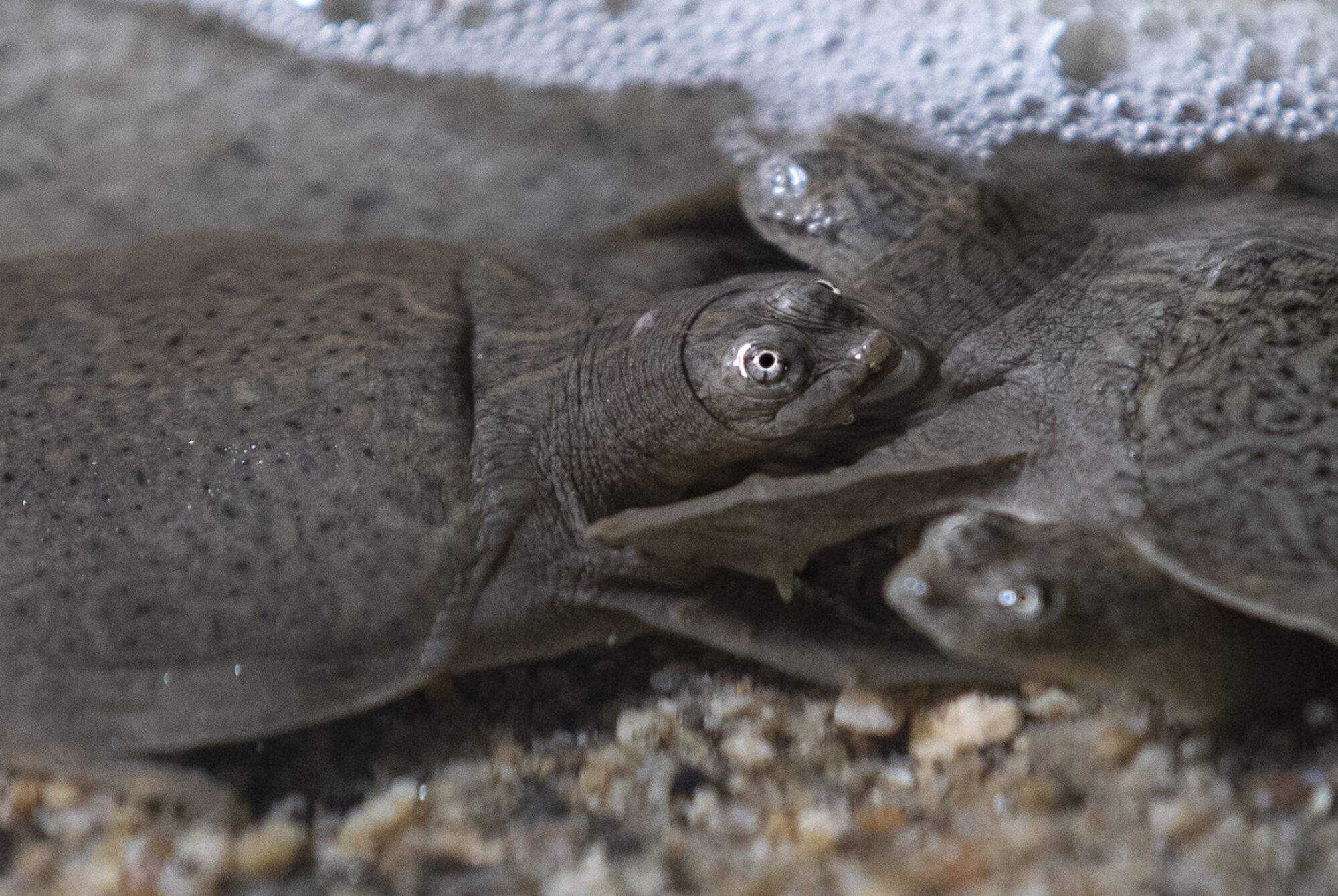Feeding the Turtles at San Diego Zoo
SAN DIEGO —
After patiently waiting decades for a trio of endangered Indian turtles to reproduce, San Diego Wildlife Alliance officials are celebrating the arrival of 41 hatchlings this summer.
This marks the first successful captive breeding in North America of the Indian narrow-headed softshell turtles, a freshwater species native to the Indian subcontinent.
The San Diego Zoo first acquired two young turtles in 1997 amid heightened concern over declining numbers of Asian turtles, which face threats such as habitat loss and water pollution, as well as demand from the international pet trade and being exported to markets as food.
The zoo had a goal of breeding the turtles and learning more about the species to help conservation efforts. Back then, not much was known about them, including their exact ages and when they would become sexually mature. Zookeepers weren't even sure if the two they received were a potential breeding pair.
They weren't.
"You can normally tell the sex of some species of turtles by the shell shape on the bottom and also the tail length; but when you're comparing two animals that you've never seen before and there's very little information about them, it is hard to determine if you think their tail is indicating male or female," said Kim Gray, curator of herpetology and ichthyology at the San Diego Zoo. "I think there was some guesswork involved early on."
After figuring out they had two females, the zoo acquired a male in 2001.
As the turtles got older, zoo staff kept a close eye on them and hoped for babies. The trio live in Mesa Crocodile Habitat along with other turtles and Indian crocodilians known as gharial.
"All we knew was we wanted to make their habitat as natural as possible, make them as comfortable as possible and just keep our fingers crossed," Gray said.

Davis Provan, senior wildlife care specialist, checks on an Indian narrow-headed softshell turtle hatchlings. The San Diego Zoo recently found 41 of the turtles. The endangered species is carnivorous and eat fish, crustaceans and frogs.
(Ana Ramirez/The San Diego Union-Tribune)
In the wild, the turtles typically live in deep rivers and streams in northern India, Bangladesh and Nepal. Adults can reach up to 440 pounds and lay up to 190 eggs in a clutch. Researchers think they may live 100 years or longer in the wild.
The zoo's habitat, found along Reptile Walk, tries to mimic what's found in nature. The pool is filled with fish and boasts several shallow underwater perches where turtles can burrow into sand, as well as beach areas where they can sit in the sun and nest.
After years of seeing no breeding activity, keepers planned slight changes to the exhibit to provide a sandy area with enough room where two turtles could burrow in the sand right next to each other. Before they could make the alteration, however, nature stepped up.
"The stars just aligned," said Davis Provan, a senior wildlife care specialist who has worked with reptiles at the San Diego Zoo for the past five years.

The San Diego Zoo welcomed 41 Indian narrow-headed softshell turtle hatchlings this summer. The endangered species is carnivorous and eat fish, crustaceans and frogs.
(Ana Ramirez/The San Diego Union-Tribune)
Keepers typically rake the habitat's beach areas each morning to look for animal activity. One day in June, Provan found a nest built in the sand by one of the turtles, filled with dozens of eggs. That nest was a dud — the eggs weren't buried deep enough, and some were broken — but over the next several days, the keepers found more nests.
Zoo staffers think both females laid the eggs, which are a little smaller than pingpong balls. Mother turtles try their best to hide the eggs so they don't fall prey to predators.
In all, keepers found four clutches in the sand. They gathered up the eggs, incubating the ones that looked to be the healthiest, and ended up with 11 hatchlings emerging in August.
Then in early September, there was a surprise: 30 more turtles were found in the outdoor habitat just as staff members were getting ready to drain the pond, maintenance they do once a year. Keepers spotted tiny turtles on the beach and in the pool.
Turns out, they had missed a clutch.
"We thought we were done, then we found even more," Provan said.

The San Diego Zoo said its the first zoo in North America to hatch Indian narrow-headed softshell turtles.
(Ana Ramirez/The San Diego Union-Tribune)
For now, all 41 hatchlings have been moved inside so they won't be eaten by other reptiles in the habitat or perhaps by local birds that frequent the zoo. The babies are just 8 to 10 grams and can fit in the palm of a person's hand.
Once the hatchlings are bigger, the zoo plans to donate about half of them to other zoos and aquariums interested in having them in their collections.
"They are kind of cute, in their strange way — they have a funny little nose that looks like a snorkel and very long necks," Gray said. "They squeeze their necks into their shell, so they look like they are wearing a turtleneck with this little snorkel nose."
To take a breath, the turtle stretches its neck up to the water's surface to take a gulp of air. They do that every half hour or so.
The species has been on the International Union for Conservation of Nature's "red list of threatened species" since 2000, when an assessment was completed. Researchers don't know how many there are now but the wild population no doubt is in worse shape than it was then, Gray said.
Sand mining operations and polluted river water threaten the turtles' habitat, while demand for their eggs and meat also threaten the species.
With its reproductive success, the zoo will be able to provide valuable information about caring for and hatching turtles to other zoos as well as increase public awareness that turtles are in trouble in the wild, Gray said. The Wildlife Alliance is working with groups such as the Turtle Survival Alliance, or TSA, to help host wetlands workshops in India.
"Our work with TSA India really highlights the long-term partnership needed to help save irreplaceable species such as these turtles," Nadine Lamberski, chief conservation and wildlife health officer at San Diego Zoo Wildlife Alliance said in a statement.
Gray said she's hopeful with this initial breeding success that more Indian narrow-headed softshell turtle babies are in the zoo's future.
"I think this is just the start of them reproducing for us," she said.
Source: https://www.sandiegouniontribune.com/news/environment/story/2022-10-03/after-long-wait-san-diego-zoo-welcomes-41-endangered-turtle-hatchlings-celebrates-reproductive-triumph
0 Response to "Feeding the Turtles at San Diego Zoo"
Post a Comment